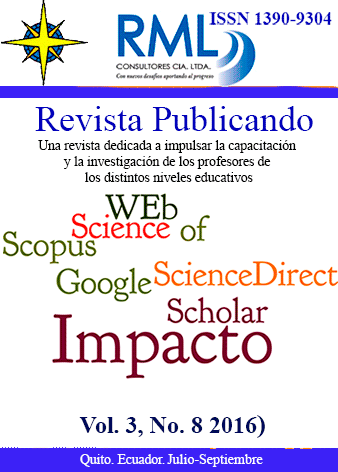Resumen
Esta investigación se propuso una revisión de las publicaciones sobre TIC en educación pero circunscribiendo la misma a las revistas científicas de alto impacto indexadas en Scopus. Para la realización de la búsqueda se seleccionó el término en idioma inglés, “Information and Communication Technologies AND education”.
De acuerdo con ello se obtuvieron un total de 854 referencias desde los años 1985 al 2016. De este total 520 es decir aproximadamente el 61% corresponde al periodo 2011-2016.
La producción científica en el tema se concentra en USA y en el Reino Unido, aunque la aparición de España en tercer lugar y de Nigeria en cuarto debido a la realización de proyectos internacionales en este último país, indica un cambio importante. En relación con los países latinoamericanos aparecen sólo publicaciones de Venezuela (4), Chile (3), Ecuador (3) Cuba (2) lo que marca el bajo nivel de acceso de publicaciones de estos países en revistas de alto impacto.
Se pudieron determinar los artículos de mayor impacto y se resumieron como aspectos importantes que más que una revolución por la introducción de las TIC se mantiene una incorporación gradual en que se sigue requiriendo investigaciones que puedan identificar cambios reales en los procesos de enseñanza aprendizaje. La denominada brecha digital entre estudiantes y profesores sigue apareciendo como una temática de investigación importante y a pesar del avance de las redes sociales se reportan pocas investigaciones sobre el impacto real de estas así como son pocas las investigaciones que reportan modelo y estudios cuantitativos que permitan generalizar los factores que incidan en una introducción efectiva de las TIC para los distintos niveles educativos
Referencias
Albirini, A. (2006). Teachers' attitudes toward information and communication technologies: the case of Syrian EFL teachers. Computers and Education, 47(4), 373-398. doi:10.1016/j.compedu.2004.10.013
Angeli, C., & Valanides, N. (2005). Preservice elementary teachers as information and communication technology designers: An instructional systems design model based on an expanded view of pedagogical content knowledge. Journal of Computer Assisted Learning, 21(4), 292-302. doi:10.1111/j.1365-2729.2005.00135.x
Ban, E., & Bronzin, T. (2013). More efficient training of teachers of informatics using modern information-communication technology in Croatian Education and Teacher Training Agency. Paper presented at the 2013 36th International Convention on Information and Communication Technology, Electronics and Microelectronics, MIPRO 2013 - Proceedings.
Coy, W. (1994). Cultural stability and technological change: The case of information, communication and media technology.
Chandrasekhar, C. P., & Ghosh, J. (2001). Information and communication technologies and health in low income countries: The potential and the constraints. Bulletin of the World Health Organization, 79(9), 850-855.
Falagas, M. E., Pitsouni, E. I., Malietzis, G. A., & Pappas, G. (2008). Comparison of PubMed, Scopus, web of science, and Google scholar: strengths and weaknesses. The FASEB journal, 22(2), 338-342.
Garfield, E. (2003). The meaning of the impact factor. Revista internacional de psicología clínica y de la salud= International journal of clinical and health psychology, 3(2), 363-369.
Jooybari, M. G., Rad, M. R., & Shiyadeh, S. F. H. (2013). Using effective models of information and communication technology in higher education. Research Journal of Applied Sciences, Engineering and Technology, 6(14), 2676-2680.
Kirkup, G., & Kirkwood, A. (2005). Information and communications technologies (ICT) in higher education teaching - A tale of gradualism rather than revolotion. Learning, Media and Technology, 30(2), 185-199. doi:10.1080/17439880500093810
Kirkwood, A., & Price, L. (2005). Learners and learning in the twenty-first century: What do we know about students' attitudes towards and experiences of information and communication technologies that will help us design courses? Studies in Higher Education, 30(3), 257-274. doi:10.1080/03075070500095689
Leena, K., Tomi, L., & Arja, R. (2005). Intensity of mobile phone use and health compromising behaviours - How is information and communication technology connected to health-related lifestyle in adolescence? Journal of Adolescence, 28(1), 35-47. doi:10.1016/j.adolescence.2004.05.004
Ostini, M. F. (1985). The application of new information and communication technologies in higher education teaching: A perspective. Higher Education in Europe, 10(4), 20-27. doi:10.1080/0379772850100404
Shaw, G., & Marlow, N. (1999). The role of student learning styles, gender, attitudes and perceptions on information and communication technology assisted learning. Computers and Education, 33(4), 223-234.
Soleimani, N., & Zamani, B. E. (2012). The relation between teachers' concern toward information and communication technology and levels of their usage according to concern based adoption model. Iranian Journal of Information Processing Management, 27(2), 429-443.
Stromscheim, J. P., & Holm, O. A. (1991). Implementing information technology as a tool in education: experiences and considerations from a communication project. Education & computing, 7(3-4), 273-277.
Walat, W. (2010). Necessity of education changes under developing information and communication technologies (ICT). Informatologia, 43(2), 116-121.
Ward, J. P. T., Gordon, J., Field, M. J., & Lehmann, H. P. (2001). Communication and information technology in medical education. Lancet, 357(9258), 792-796. doi:10.1016/S0140-6736(00)04173-8
Waycott, J., Bennett, S., Kennedy, G., Dalgarno, B., & Gray, K. (2010). Digital divides? Student and staff perceptions of information and communication technologies. Computers and Education, 54(4), 1202-1211. doi:10.1016/j.compedu.2009.11.006
Wu, J. H., Tennyson, R. D., & Hsia, T. L. (2010). Engaging learning models with information and communication technologies in advancing electronic learning Electronic Globalized Business and Sustainable Development Through IT Management: Strategies and Perspectives (pp. 205-221).
Yokota, M. (1988). Active and passive information transmission: technology of communication. [Hokenfu zasshi] The Japanese journal for public health nurse, 44(8), 714-718.
Usted es libre de:
Compartir — copiar y redistribuir el material en cualquier medio o formato
Adaptar — remezclar, transformar y construir a partir del material
La licenciante no puede revocar estas libertades en tanto usted siga los términos de la licencia
Bajo los siguientes términos:
Atribución — Usted debe dar crédito de manera adecuada, brindar un enlace a la licencia, e indicar si se han realizado cambios. Puede hacerlo en cualquier forma razonable, pero no de forma tal que sugiera que usted o su uso tienen el apoyo de la licenciante.
NoComercial — Usted no puede hacer uso del material con propósitos comerciales.
CompartirIgual — Si remezcla, transforma o crea a partir del material, debe distribuir su contribución bajo la lamisma licencia del original.
